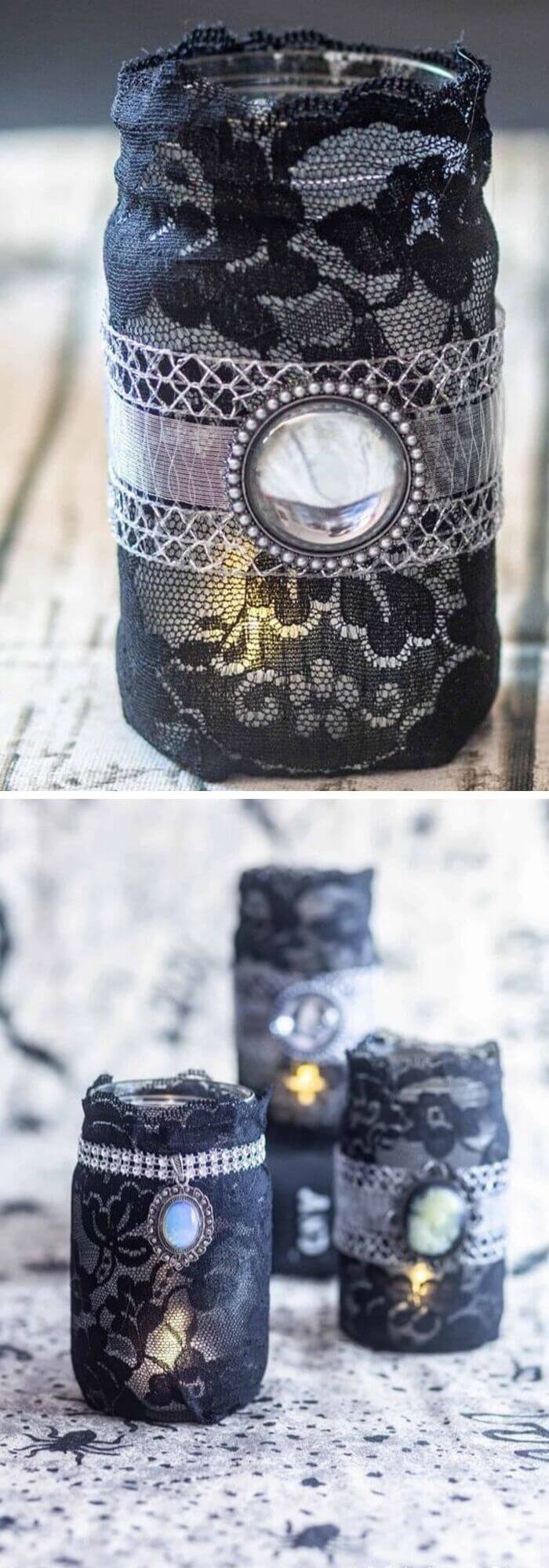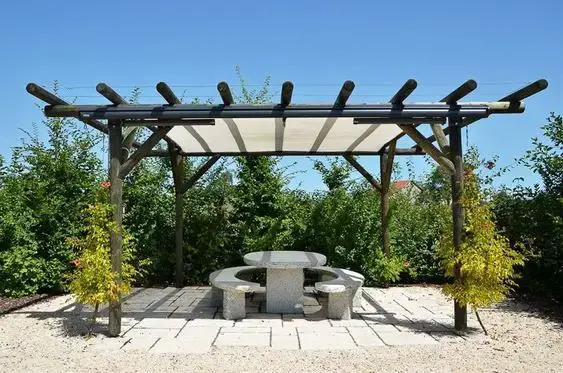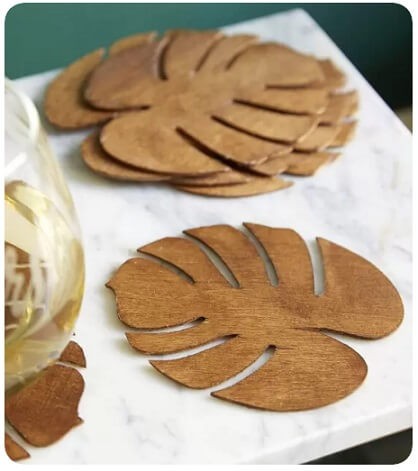Bottle Brush Tree: Varieties, Growing And Caring For Callistemon
For those seeking an unconventional yet stunning addition to their outdoor space, the bottlebrush tree – actually a shrub – may be the perfect choice. Native to Australia, this versatile plant offers numerous varieties that can cater to different climates, yard styles, and personal preferences. The array of available types ensures that gardeners can select the one that best suits their needs.
With its unique characteristics and adaptability, the bottlebrush tree is an excellent option for those looking to add a touch of distinctiveness to their garden or yard.
Bottlebrush Tree Facts
The distinctive feature of bottlebrush trees is their cylindrical flower clusters, reminiscent of a brush’s soft bristles. These delicate, fluffy blooms come in shades of red, pink, orange, and white. The leaves, meanwhile, are long and slender, ranging from light to dark green in color, often growing through the cluster of flowers to create an intriguing visual effect.
While bottlebrush trees can reach impressive heights of up to 15 feet tall, with flower clusters stretching 12 inches long, they are surprisingly adaptable and can be pruned down for container cultivation. This hardiness allows them to thrive in various environments. Native to Australia’s temperate regions, bottlebrush trees have gained popularity worldwide, becoming a favorite among gardeners globally.
In the United States, they excel in hardiness zones eight through 11, although their pot-friendly nature also makes them an excellent choice for greenhouses.
Types of Bottlebrush Trees
Crimson Bottlebrush (Melaleuca citrina)
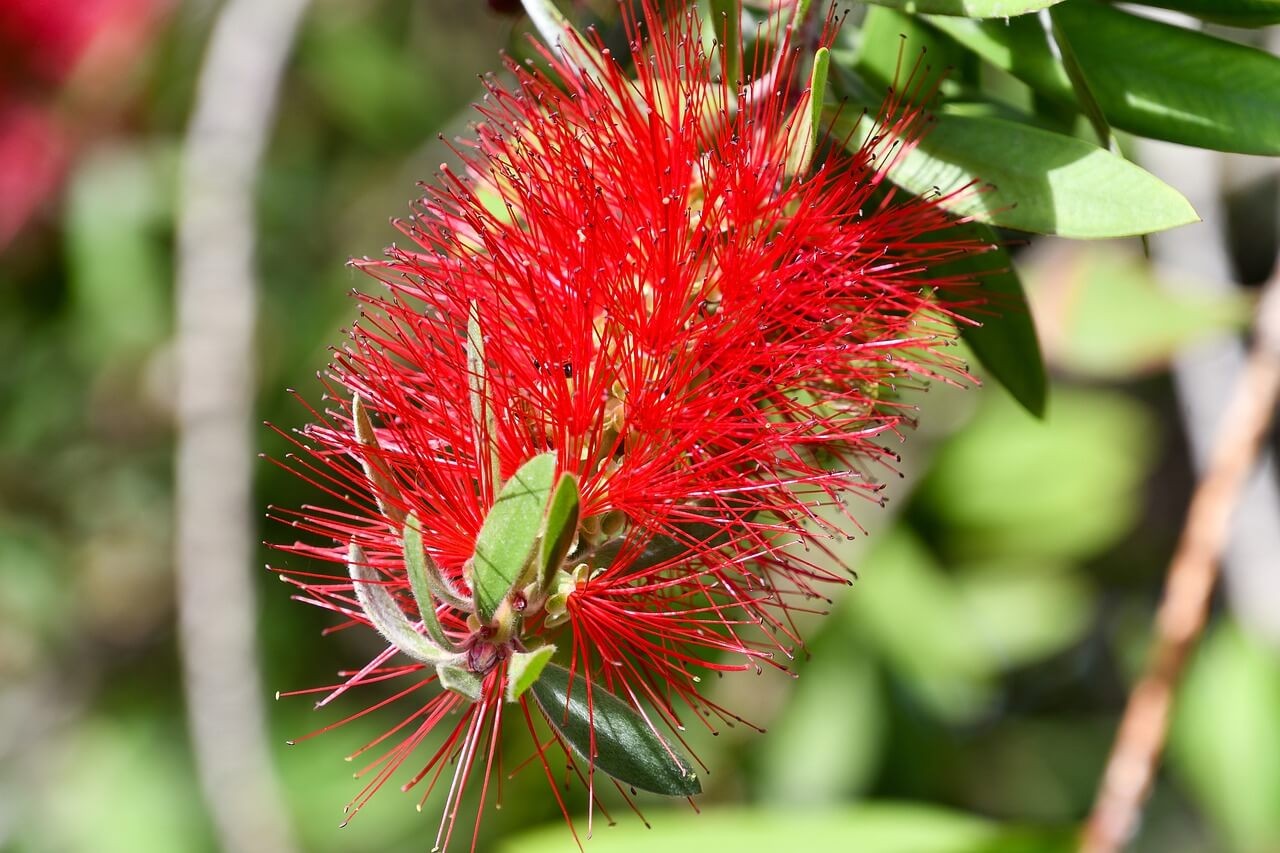
The vibrant red blooms of the crimson bottlebrush are its most striking feature. However, this plant has more to offer than just its stunning flowers. Its dense foliage and branching habit make it an excellent choice for creating a hedge or topiary. As the plant matures, its branches develop a natural arch, adding visual interest to any garden.
Interestingly, the crimson bottlebrush is also known by several other names, including Melaleuca citrina, Callistemon citrinus, and Callistemon citrinus ‘Splendens’.
Weeping bottlebrush, creek bottlebrus (Melaleuca viminalis, Callistemon viminalis)
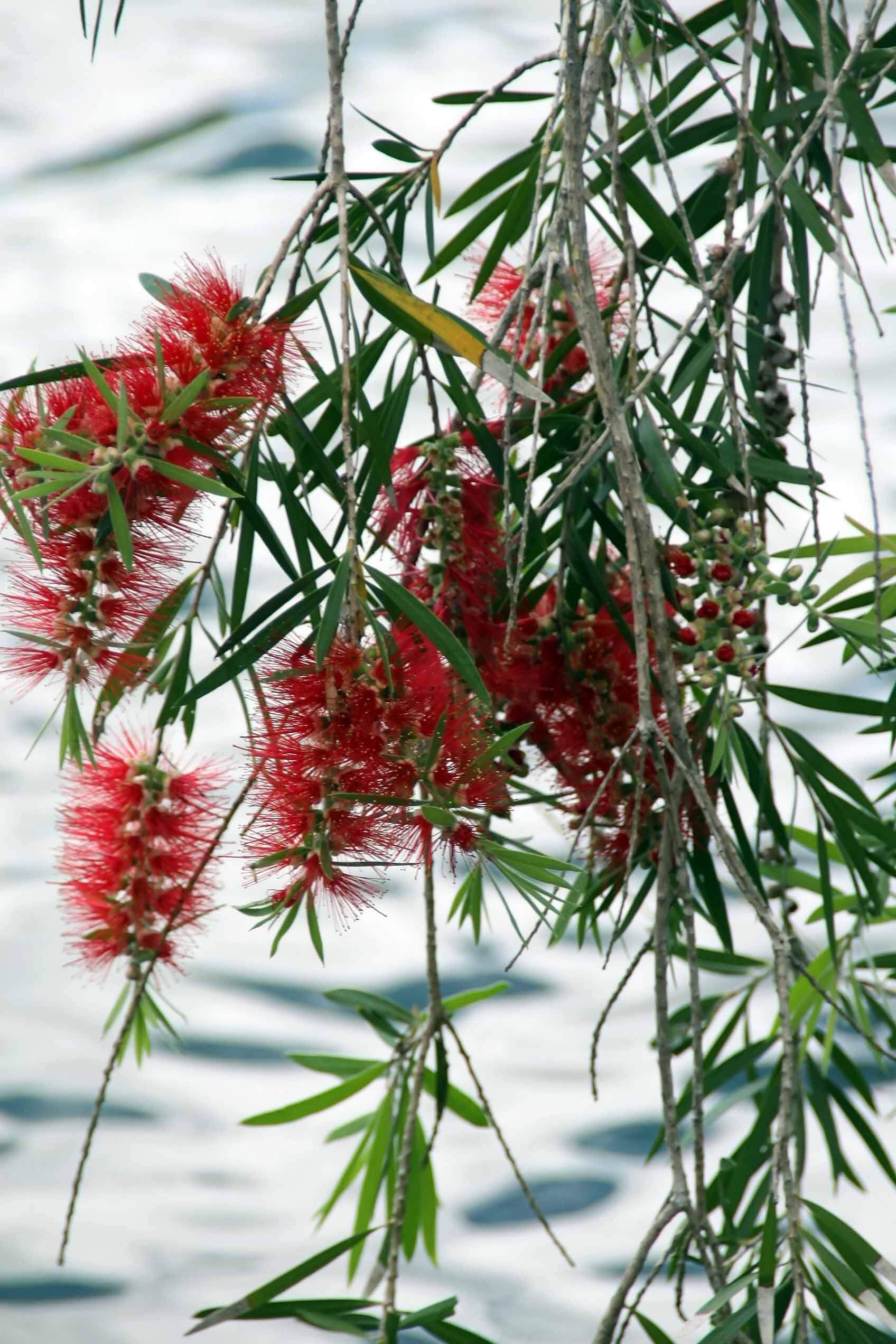
A popular choice among gardeners, Melaleuca viminalis – also known as the weeping bottlebrush – boasts vibrant red flowers that are impossible to miss. Its striking appearance is largely due to the abundance and size of its blooms, which hang attractively from its branches. This unique combination has earned it a spot as one of the most sought-after bottlebrush varieties.
Stiff Bottlebrush (Callistemon rigidus)
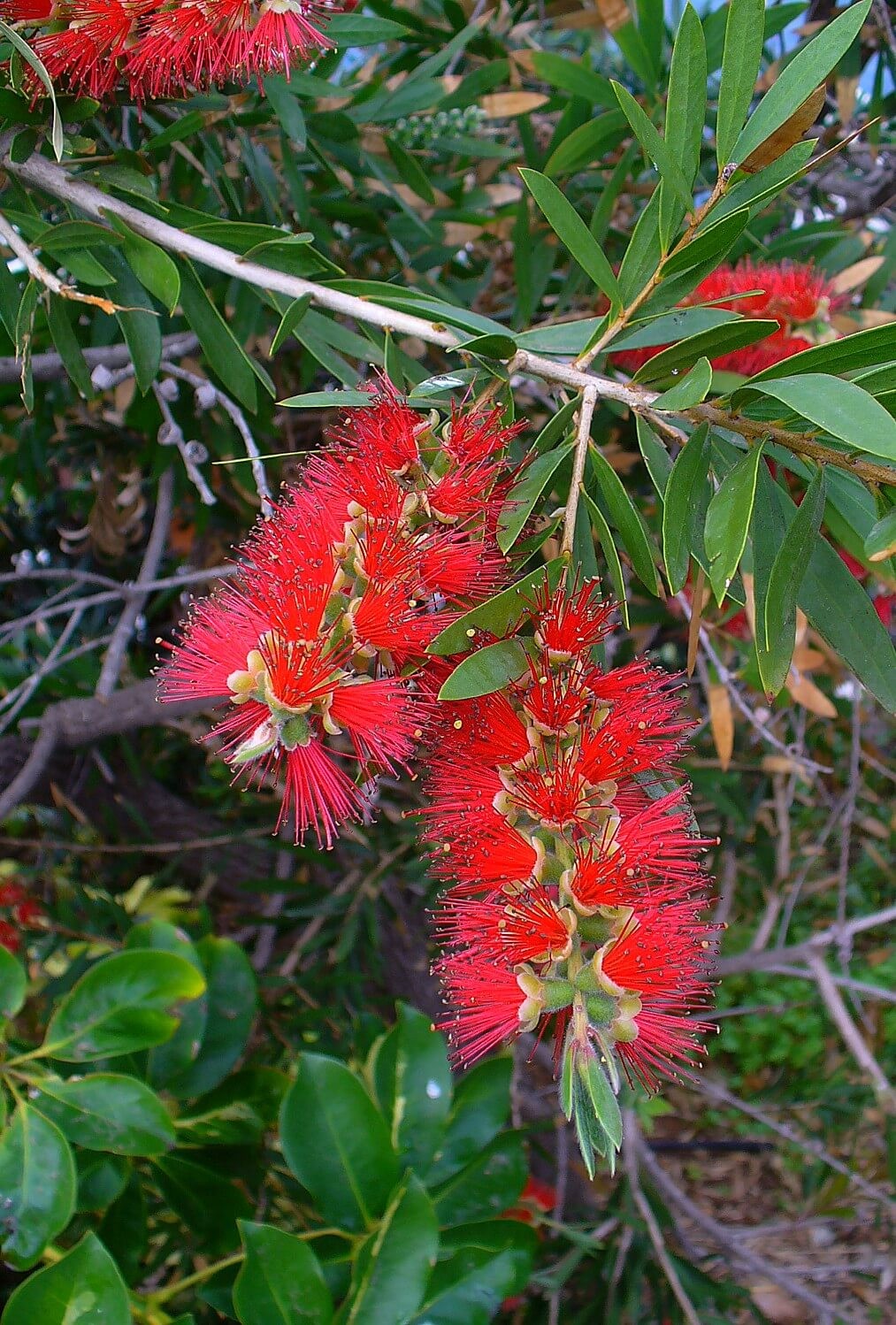
While Callistemon rigidus, also known as the stiff bottlebrush, may not boast the showy weeping branches of its crimson counterpart, it offers a unique set of characteristics that make it an attractive option for gardeners. The plant’s stiffer and straighter stems allow for greater versatility in terms of pruning and maintenance. This makes it an excellent choice for those looking to create a hedge or container arrangement.
With proper care, Callistemon rigidus can be kept at a manageable height between 3 and 8 feet tall, making it an ideal addition to smaller gardens or patios.
Albany bottlebrush (Callistemon speciosus)
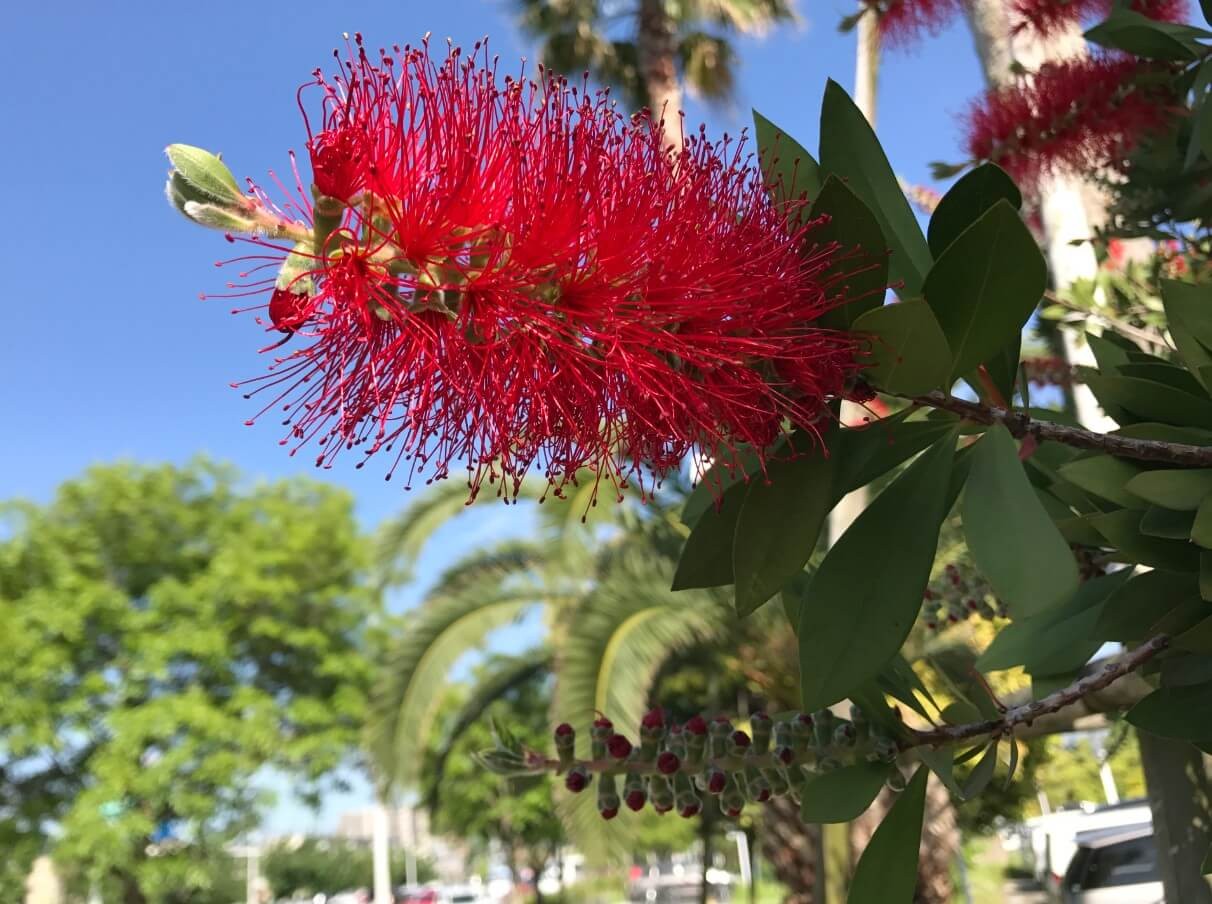
The Albany bottlebrush (Callistemon speciosus) is native to the warm southwest of Australia, where it flourishes along waterways. Its striking red blooms are accompanied by sturdy, upright branches that set it apart from other bottlebrush trees. Notably, this species is less dense than its counterparts, offering a unique opportunity for shaping through pruning. When pruned, the Albany bottlebrush can take on a tree-like appearance, rather than a traditional shrub form.
Lemon bottlebrush (Callistemon pallidus)
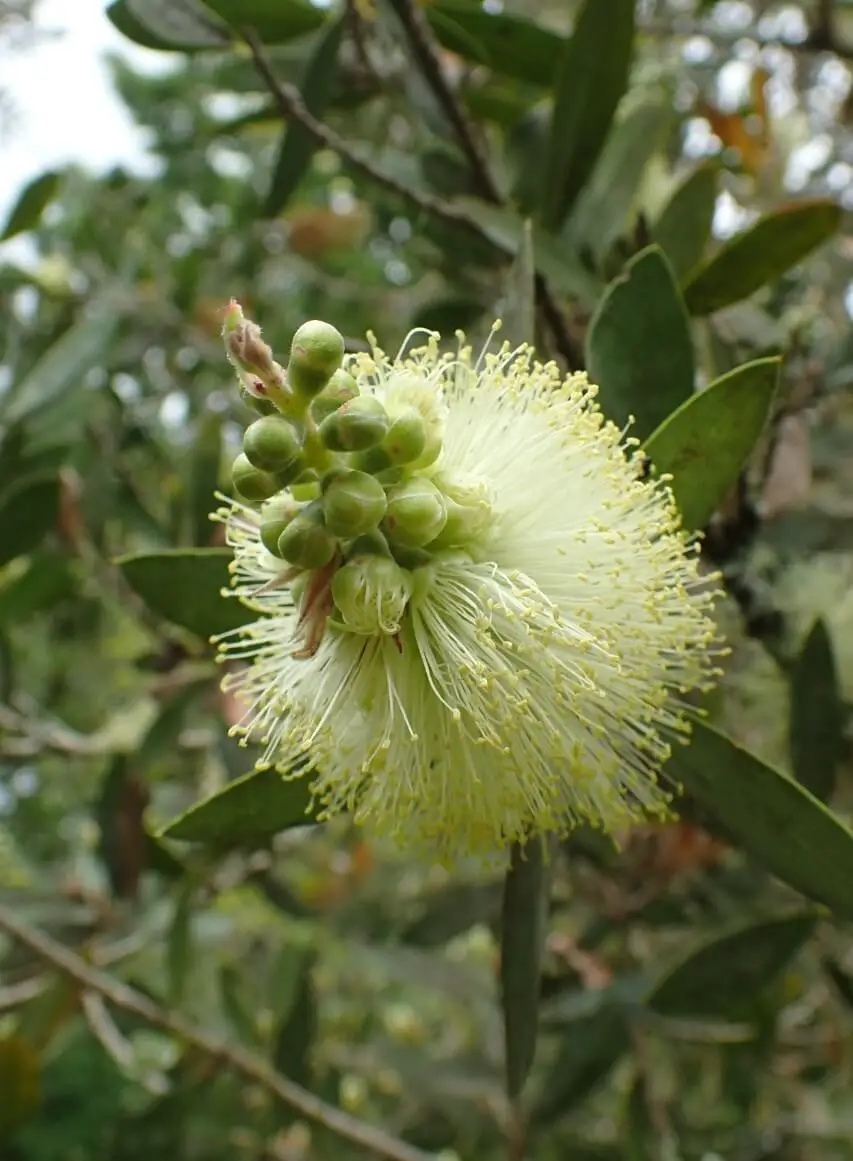
While Callistemon pallidus, also known as the lemon bottlebrush, is a member of the popular bottlebrush family, it deviates from its more vibrant counterparts in terms of flower color. Instead of showcasing bold reds and pinks, the lemon bottlebrush tends to display flowers that are notably lighter, often taking on a soft yellow or off-white hue. The plant’s stems themselves are slender yet robust, growing upright with an air of elegance.
Alpine Bottlebrush (Melaleuca pityoides)
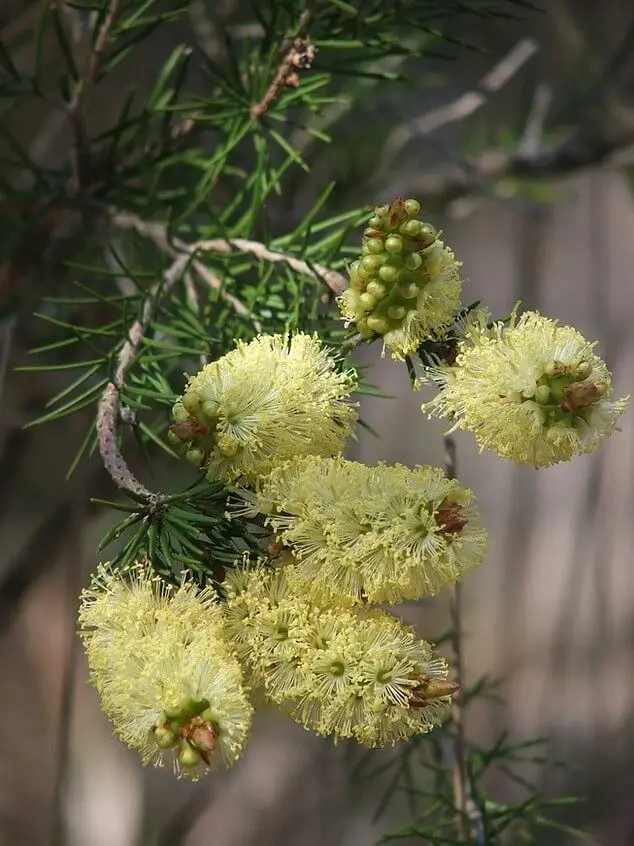
The alpine bottlebrush (Callistemon sieberi) is characterized by its densely foliated appearance, boasting narrow leaves with a texture reminiscent of pine needles. This compact species grows to a relatively modest height of 3-6 feet, making it an ideal choice for hedges and borders. Its delicate pale yellow or off-white flowers add a touch of elegance, while the plant’s natural tendency to remain small ensures easy pruning into shape, perfect for maintaining a tidy appearance.
Cliff bottlebrush (Callistemon comboynensis)
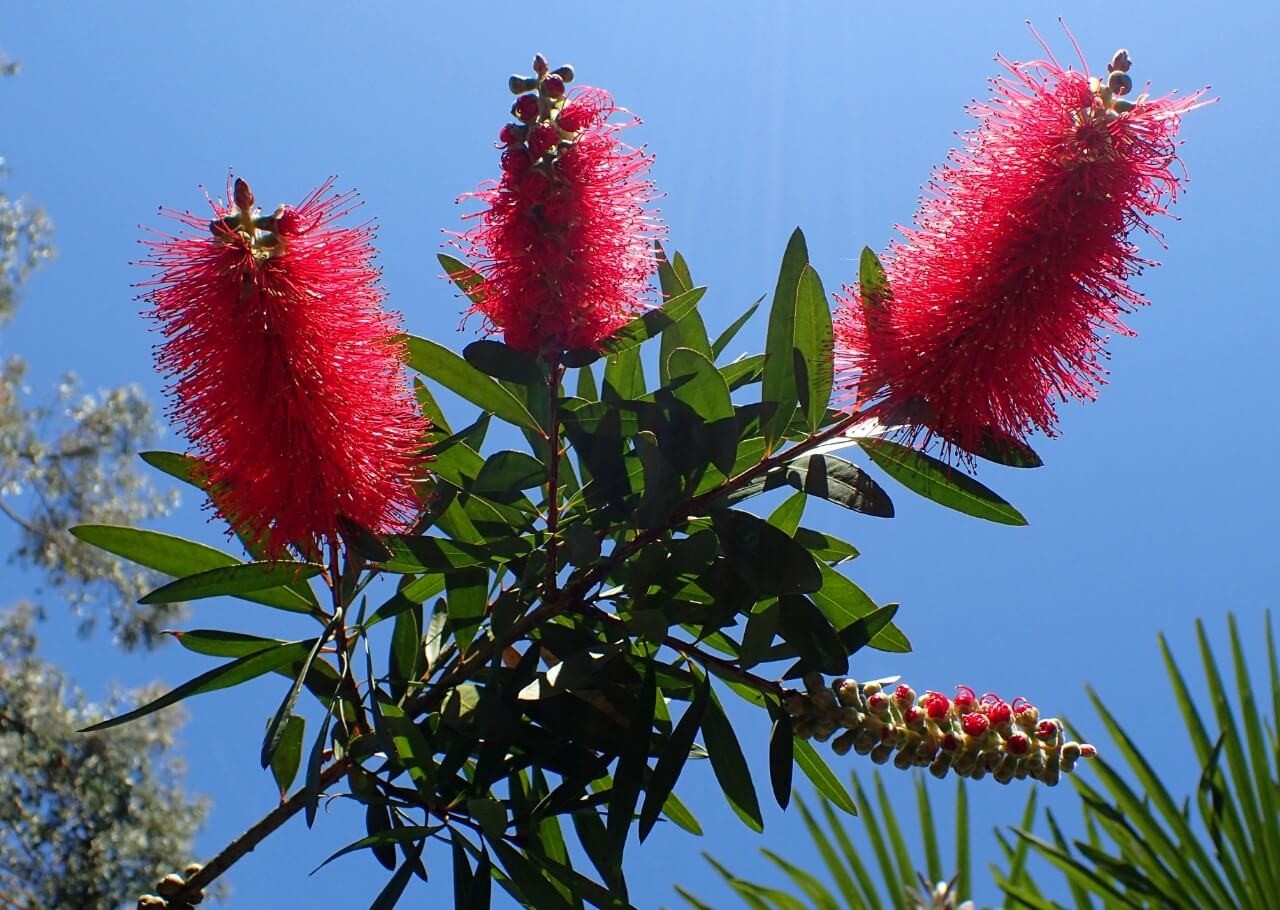
The cliff bottlebrush (Callistemon comboynensis) bears a striking resemblance to its crimson counterpart. A key distinguishing feature is the slightly wider leaf shape. As its common name implies, this plant has a penchant for growing in rugged environments, often nestled amongst cliffs or wedged between rocks, where it can thrive in the harsh conditions.
Wallum Bottlebrush (Melaleuca pachyphylla)

Melaleuca pachyphylla, commonly known as the wallum bottlebrush, is an indigenous Australian species that thrives along the country’s coastal regions. This striking plant can reach heights of around 10 feet, with trailing branches that often sprawl rather than standing upright. The vibrant flowers of Melaleuca pachyphylla typically exhibit a deep red hue, although occasional green blooms have been observed.
Its dense foliage makes it an attractive choice for hedging or barrier landscaping purposes.
Needle bottlebrush (Callistemon teretifolius)
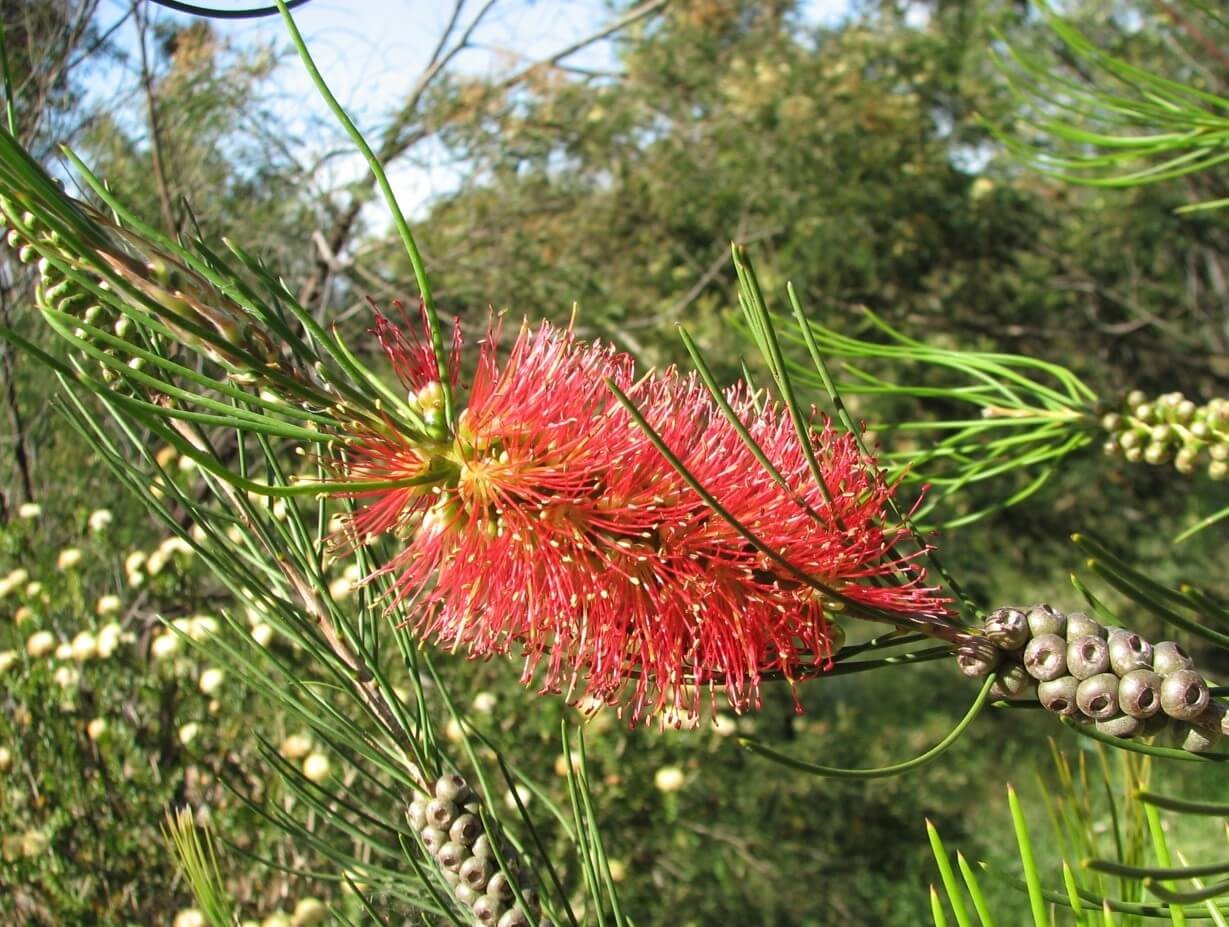
The Callistemon teretifolius, affectionately known as the needle bottlebrush, is distinguished by its slender, pointed leaves. This attractive shrub reaches heights of approximately 7 feet, with vibrant red or orange flowers featuring subtle green undertones. Like many other bottlebrush species, it not only boasts a stunning visual appeal but also serves as a magnet for butterflies and hummingbirds in the garden, making it a popular choice among ornamental plant enthusiasts.
Life Cycle of the Bottlebrush Plant
After planting, the bottlebrush plant’s seeds typically take between two weeks and one month to germinate. As the young plant emerges, it requires meticulous care as it develops. Consistent watering is essential, but it’s crucial to avoid overwatering, which can lead to root rot or other issues.
The tender leaves of newly sprouted bottlebrush trees often emit a sweet, citrusy aroma reminiscent of lemon or evergreen. Most varieties begin blooming around six years after planting.
Growth rates vary among different bottlebrush species, but most will grow approximately one foot annually. Some smaller types may have a slower growth rate, while others can reach up to 3 feet per year. Once the plant reaches maturity, it will consistently produce flowers and seeds for many years.
Bottlebrush trees are known to live for around 50 years, although most typically succumb to old age after about 40 years.
Bottlebrush Tree Care
Watering
Bottlebrush trees possess an impressive resilience to drought, making them relatively low-maintenance in terms of watering. However, this adaptability also means that root rot can become a problem if they’re over-watered. As such, it’s crucial to only irrigate these plants when absolutely necessary. Typically, mature bottlebrush trees growing outdoors require no additional water and thrive solely on rainfall.
In arid climates, applying a layer of mulch can aid in retaining moisture and maintaining a consistent soil humidity. For newly planted bottlebrush trees, daily watering is recommended for the initial week post-transplanting. Ensure the soil remains moist but allows for some drying between each irrigation. Following this first week, water them only twice weekly for the next month before gradually phasing out watering altogether, provided rain showers remain consistent.
Young bottlebrush trees require about one weekly watering until maturity. When hydrating, thoroughly soak the soil and let it almost completely dry out before the next watering session.
Light
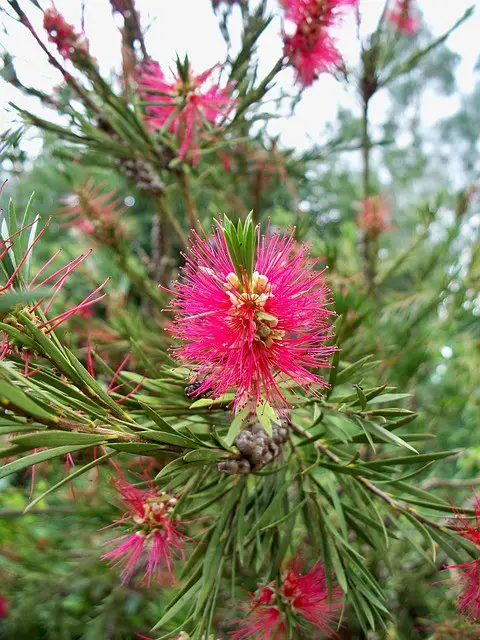
Bottlebrush trees have evolved to flourish in well-lit conditions, making them ideal for areas that receive direct sunlight. In fact, they require at least six hours of sunlight per day to reach their full flowering potential. However, it’s worth noting that even more sun exposure can further enhance the vibrancy and quantity of the blooms.
Temperature and Humidity
Bottlebrush trees thrive in temperate climates with moderate temperatures, ranging from 50 to 90 degrees Fahrenheit. While they’re generally hardy and adaptable, prolonged exposure to temperatures below 50°F can be detrimental, making it essential to either relocate them indoors or in a greenhouse during the colder months to prevent damage or even death from frost. In terms of humidity, bottlebrush plants actually prefer relatively low levels, which helps to promote healthy growth.
Soil
When it comes to growing bottlebrush trees, the type of soil is an important consideration. Fortunately, these trees are relatively flexible when it comes to soil types and can thrive in a range of conditions. As long as the soil drains well, bottlebrush trees will do just fine. In particular, peaty or loamy soils tend to be ideal for their growth.
If you’re dealing with clay-heavy soil, it’s worth mixing in some compost or another potting mix before planting to ensure optimal drainage and a healthy start for your tree.
Fertilizer
When it comes to planting your bottlebrush tree, it’s essential to consider the pH level of the soil. Ideally, you’ll want to aim for a range between 6.0 and 8.0. To give your tree the best possible start, consider incorporating compost as a covering fertilizer. This natural amendment can provide essential nutrients and help improve soil structure. As the seasons change and your tree enters its growth phase, you may also want to consider providing additional fertilization.
During the spring and summer months, a monthly application of a balanced, all-purpose fertilizer is often sufficient. However, if you’re looking to promote particularly vibrant blooms, a fertilizer with a higher phosphorus content can be an effective choice.
Potting
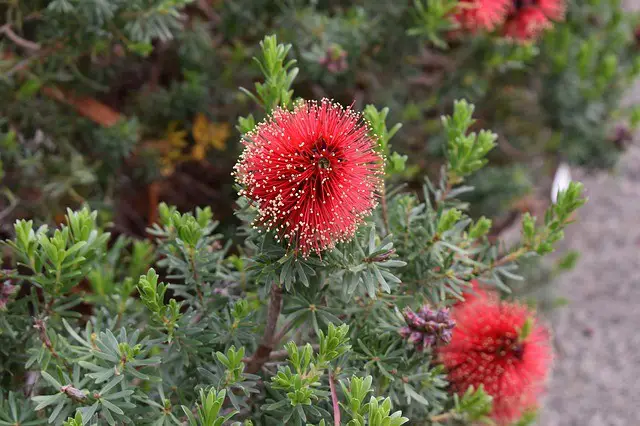
Bottlebrush trees may surprise you by thriving in pots, despite their robust size. A modest-sized container, approximately 8 inches across, is sufficient for these plants, though regular pruning will be necessary to keep growth under control. For optimal results, consider using a larger pot, such as a tub or ceramic vessel, which will provide ample space for the plant’s expansion. If needed, you can transplant it to an even larger container in the future.
When potting bottlebrush trees, remember that proper drainage is crucial. To ensure this, consider adding extra holes to the container itself or placing a layer of stones at the bottom of the pot. Additionally, mixing your potting soil with perlite can further enhance drainage and promote healthy growth.
Propagation
Propagation of bottlebrush trees is a relatively straightforward process that can be achieved through either seed germination or stem cuttings. The seeds, which are contained within fruit that resembles a wide, rounded acorn, can be harvested when they naturally split open. Each fruit yields numerous tiny seeds, which can then be planted to initiate the growth of new plants.
For those who prefer to use stem cuttings for propagation, it’s essential to take clean and precise cuts from the parent plant using sharp shears at a 45-degree angle. This approach is particularly effective during the summer months when the plant can heal quickly. The cutting should be at least six inches in length, but longer lengths are also acceptable. To prepare the cutting for planting, remove any flowers and leaves to minimize stress on the parent plant.
Then, submerge or bury the cut end of the stem in either water or soil, ensuring that it remains moist. Regularly changing the water will help prevent bacterial growth. Under ideal conditions, roots should begin to develop within two to three months.
Pruning
When it comes to pruning your bottlebrush tree, frequency and extent depend on whether you’re keeping it in a pot or not. Generally speaking, unless you’re containerizing your tree, minimal pruning is necessary. However, there are benefits to pruning – it can channel the plant’s energy towards producing more flowers, and also allow for shaping to your liking.
If you’re using pruning to shape the tree, spring is the ideal time to do so, before any blooms have appeared.
You can trim the plant into various shapes, including hedges or tree forms. When making cuts, ensure they’re clean and precise, using sharp shears. Cut just above a growth node to promote rapid healing.
In addition to shaping, bottlebrush trees also require periodic pruning to remove dead or dying branches. This can be done in spring or late summer after the plant has bloomed. Don’t forget to trim away any suckers near the roots.
Transplanting
When preparing to transplant bottlebrush trees, it’s essential to consider their hardy nature while still exercising caution. The first step is to thoroughly water the plant and allow the excess moisture to seep into the soil, helping to loosen the roots. Next, measure the trunk of the tree about 6 inches from the ground, then multiply this measurement by nine to estimate the circumference of the root system.
With this information, carefully dig a circle around the expected root area, taking care not to sever any root tendrils as long as the root ball remains intact. For mature plants, it’s crucial to excavate at least 20 inches deep to avoid damaging the roots. Once you’ve completed the transplant, keep the plant in a shaded area until you’re ready to replant. When relocating from a pot, be gentle and deliberate in your actions.
If possible, cut away any containers or gently rock the plant back and forth to loosen it. Additionally, if the roots have become bound while in the container, take the time to carefully release them.
Growing Problems
Bottlebrush trees typically experience a growth spurt of around one foot per year, reaching maturity over time. However, if your bottlebrush tree is not growing or flowering as expected, there are several potential issues to consider. A lack of light is often the primary culprit, as other plants can cast excessive shade on the tree. To address this, you may need to trim surrounding vegetation or relocate the bottlebrush tree to a location that receives consistent, full sunlight.
Another possible explanation for stunted growth is an imbalance in soil chemical levels or the type of fertilizer being used. Nitrogen plays a crucial role in promoting leaf growth, so if the tree appears less robust than expected, adjusting the nitrogen content in your fertilizer may be necessary. Conversely, if the tree is not flowering as desired, it’s possible that the nitrogen to phosphorus ratio is out of balance.
Pruning can also hinder growth if performed at the wrong time during the growing cycle. Avoid pruning your bottlebrush tree during the fall or winter, as this is when plants typically experience most of their growth. Similarly, refrain from pruning in late spring, as this can negatively impact flower development.
Pests
While bottlebrush trees are generally pest-free, a few unwanted visitors can still cause trouble. Sawfly larvae, web caterpillars, and scale insects may infest the plant, leading to issues like defoliation or sap-sucking damage. Defoliating pests, such as sawfly larvae and web caterpillars, will strip the tree of its leaves, while scale insects will feed on sap, damaging the bark and foliage.
To combat these unwanted guests, neem oil and diatomaceous earth can be effective deterrents against scale insects and sawfly larvae. If you encounter web caterpillars, it’s essential to remove the entire web to prevent further damage.
Diseases
Bottlebrush trees are prone to several fungal diseases that can cause significant damage if left untreated. One of the most common is Verticillium wilt, which causes leaves to curl up and turn brown due to a fungus present in the soil. The disease typically starts at the base of the plant and spreads upwards, making it difficult to remove the fungus completely. However, pruning away diseased branches and fertilizing well can help strengthen the plant’s ability to fight off the disease.
Another issue affecting bottlebrush trees is root rot, which occurs when the soil remains too wet for extended periods without drying out between watering. This causes fungal growth that prevents roots from absorbing water, leading to yellow or brown leaves and eventually branch death. Root rot is often difficult to cure once it sets in, so it’s essential to monitor soil drainage and watch for early signs of the disease.
Powdery mildew, characterized by white powdery spots on leaves or stems, is another fungal infection that can affect bottlebrush trees. This disease typically occurs when plants receive excessive moisture or shade, and can be treated with fungicides. Twig gall, caused by a fungal infection related to moisture issues, manifests as round, papery balls around thinner stem sections. To treat twig gall, cut away affected branches, ensure proper soil drainage, and prevent overwatering.
Lastly, leaf spot, caused by a fungus that attacks specific leaves, can cause small brown dots to form on leaves, disrupting photosynthesis. Leaf spot is usually not incurable but can harm the plant’s health if it affects more than half of the plant or recurs annually. To treat leaf spot, provide sufficient sunlight, prune away browned branches, rake fallen leaves, and ensure the tree doesn’t receive excessive moisture.
Frequently Asked Questions
How Big Does a Bottle Brush Tree Get?
Bottlebrush trees typically reach heights of around 15 feet, with some specimens exceeding 25 feet when provided with proper care and attention. Their spread can range from 3 to 20 feet wide, depending on the specific variety. Interestingly, dwarf bottlebrush tree cultivars can grow as low as 3 feet tall, making them a great option for smaller spaces or containers.
Additionally, these trees can be heavily pruned to maintain a compact shape, allowing them to thrive in confined areas or as decorative accents.
Is Bottlebrush Poisonous to Dogs?
While ornamental bottlebrush trees, hailing from Australia, are non-toxic to canine companions, it’s still crucial to refrain from allowing your pets to ingest any part of the plant. A vital distinction must be made between this Australian native and its American counterpart, the bottlebrush buckeye. The latter, although bearing a similar name, is not a genuine bottlebrush tree and poses a significant threat to our furry friends, including dogs, if ingested.
Is Bottlebrush Poisonous to Humans?
While it’s understandable to assume that bottlebrush trees are poisonous given their name, the reality is that they’re actually harmless to humans. In some cases, people even utilize the leaves to brew tea. The misconception likely stems from confusion with the North American bottlebrush buckeye, a distinct plant that is indeed toxic. It’s essential to differentiate between these two plants, as the bottlebrush tree itself poses no threat to human health.
Are Bottlebrush Roots Invasive?
While bottlebrush roots are typically not invasive and spread only as far as a typical shrub’s roots, it’s still essential to exercise caution when planting one near a structure. As the tree can grow quite large, its roots or branches may potentially cause damage to the structure if left unchecked.
How Long Do Bottlebrush Trees Live?
When it comes to unique and low-maintenance options for your garden, the bottlebrush tree is an excellent choice. With a lifespan of 20-40 years when properly cared for, this hardy plant offers a great combination of durability and adaptability. One of its most appealing features is its ability to thrive in a pot, allowing you to trim it down to fit your space constraints.
Additionally, the diverse array of varieties on offer means that gardeners can select from a range of flowers to find the perfect one for their yard’s unique character.
Conclusion
To ensure a thriving bottle brush tree, heed these valuable tips. As we concluded in our previous discussion, proper care is crucial to reaping the rewards of this beautiful plant. With these guidelines, you’ll be well on your way to becoming a skilled gardener. For additional gardening insights and beginner-friendly guides, visit our homepage for more information.
Related Posts
For those looking to explore the wonderful world of online plant nurseries, it’s essential to understand the vast variety of options available. From apple trees to evergreens, there are countless species to discover. In fact, becoming an arborist and dedicating your career to tree care can be a rewarding path. But before we dive into that, let’s examine the impact that trees can have on a property.
Not only do they provide shade and beauty, but they also play a crucial role in boosting a home’s appeal. Of course, there are times when removing trees is necessary, and this too can enhance a property’s curb appeal. When it comes to specific species, the lady palm (Rhapis excelsa) is a popular choice for many gardeners. With proper care and attention, these plants can thrive in even the most challenging environments.
For those looking to grow organic blueberry plants, there are many tips and tricks to keep in mind. By understanding what makes these plants tick, you’ll be well on your way to creating a bountiful harvest.



